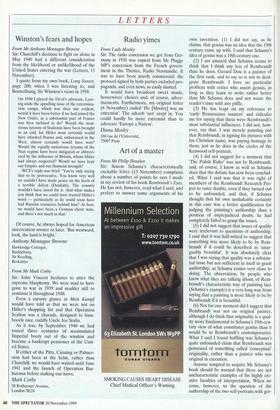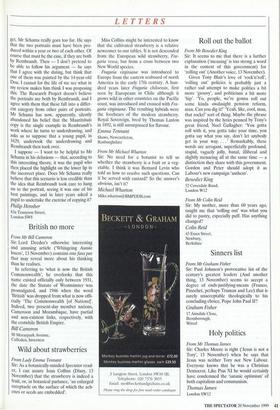Art of a master
From Mr Philip Hensher
Sir: Simon Schema's characteristically excitable letter (13 November) complains about a number of points he says I made in my review of his book Rembrandt's Eyes. He has not, however, read what I said, and prefers to answer some arguments of his own invention. (1) I did not say, as he claims, that genius was an idea that the 19th century came up with. I said that Schama's idea of genius was a 19th-century one.
(2) I am amazed that Schama seems to think that I think any less of Rembrandt than he does. Gerard Dou is a painter of the first rank, and to say so is not to deni- grate Rembrandt. I have no particular problem with critics who assert genius, as long as they learn to write rather better than Mr Schama does and not waste the reader's time with airy piffle.
(3) He has leapt on my reference to 'early Renaissance masters' and ridicules me for saying that these were Rembrandt's most substantial influences. I did not, how- ever, say that. I was merely pointing out that Rembrandt, in signing his pictures with his Christian name, was paying homage to them, just as he does in the circles of the Kenwood self-portrait.
(4) I did not suggest for a moment that 'The Polish Rider' was not by Rembrandt, and, of course, I know as well as Schama does that the debate has now been conclud- ed. What I said was that it was right of members of the Rembrandt Research Pro- ject to voice doubts, even if they turned out to be unfounded, and that, if Schama thought that his own unshakable certainty in this case was a better qualification for judging the painting's authorship than a position of unprejudiced doubt, he had completely failed to grasp the issues.
(5) I did not suggest that issues of quality were irrelevant to questions of authorship. I said that it was half-witted to suggest that something was more likely to be by Rem- brandt if it could be described as 'unar- guably beautiful'. It was absolutely clear that I was saying that quality was a substan- tial issue but not sufficient in itself to grant authorship, as Schama comes very close to doing. The observation, by people who know what they are talking about, of Rem- brandt's characteristic way of painting lace (Schama's example) is a very long way from saying that a painting is more likely to be by Rembrandt if it is beautiful.
(6) Not for one moment did I suggest that Rembrandt was not an original painter, although I do think that originality is a qual- ity more fundamental to Schama's 19th-cen- tury view of what constitutes genius than it would be to Rembrandt's contemporaries. What I said I found baffling was Schama's quite unfounded claim that Rembrandt was /possessed of something called 'conceptual' Originality, rather than a painter who was original in execution.
Anyone tempted to acquire Mr Schama's book should be warned that these are not uncharacteristic examples of his highly cre- ative faculties of interpretation. When we come, however, -to the question of the authorship of the two self-portraits with gor- get, Mr Schama really goes too far. He says that the two portraits must have been pro- duced within a year or two of each other. Of course that must be the case, if they are both by Rembrandt. Then — I don't pretend to be able to follow his argument — he says that I agree with the dating, but think that one of them was painted by the 14-year-old Dou. I cannot for the life of me see what in my review makes him think I was proposing this. The Research Project doesn't believe the portraits are both by Rembrandt, and I agree with them that these fall into a differ- ent category from other pairs of portraits. Mr Schama has now, apparently, silently abandoned his belief that the Mauritshuis copy is the single example in Rembrandt's work where he turns to underdrawing, and asks us to suppose that a young pupil, in 1629, undertook the underdrawing and Rembrandt then took over.
I suppose —'I want to be helpful to Mr Schama in his delusions — that, according to this interesting theory, it was the pupil who then placed the highlight on the lower lip in the incorrect place. Does Mr Schama really believe that this scenario is less credible than the idea that Rembrandt took care to hang on to the portrait, seeing it was one of his best paintings, and in later years asked a Pupil to undertake the exercise of copying it? Philip Hensher 83a Tennyson Street, London SW8



























































































 Previous page
Previous page